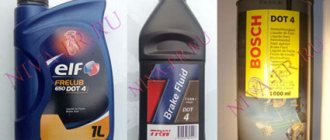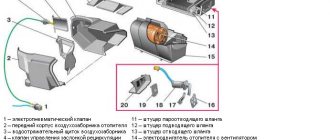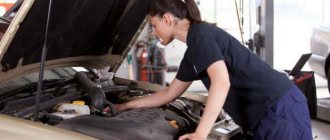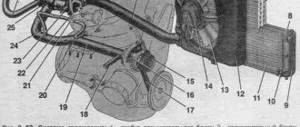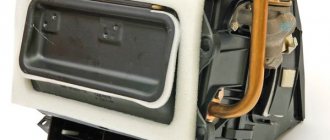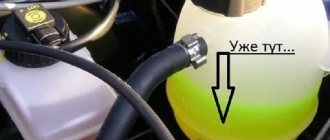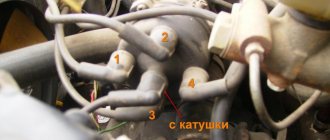Without a cooling system, the operation of an internal combustion engine is impossible. The SOD serves to quickly warm up the engine to the optimal temperature and removes excess heat, preventing the power plant from overheating. The VAZ 2110 is equipped with a standard ODS. It is reliable, but if breakdowns occur, repair or replacement cannot be delayed. Otherwise, a faulty system threatens rapid wear of engine parts until it fails.
Cooling system
Design and operating principle of SOD VAZ 2110
The diagram of the heat removal system installed on the VAZ 2110 is classic for an injector. The composition includes a main radiator, a heater, a water pump, a thermostat, an expansion tank, a forced cooling fan, a temperature sensor, an ECU and several connecting pipes.
Radiator
The radiator on the VAZ 2110 is used in the system only when antifreeze moves through a large duct - passing through it, the working fluid is cooled. It is usually an aluminum body with tubes on the inside and plates on the outside, also called honeycomb. It is equipped with two plastic tanks, separated by walls, through which antifreeze moves. When the large circle opens, the coolant enters the radiator through the upper outlet, and the outlet is the lower one.
Expansion tank
It is made of heat-resistant plastic and is intended for filling coolant and monitoring its level. There are “minimum” and “maximum” marks on the wall; in normal condition, the level should be at the middle mark. The tank has two pipes, one of them serves to remove steam from the main radiator, the other - excess heat from the stove radiator.
A special valve cover is installed on the expansion tank of the VAZ 2110, which is responsible for the tightness of the entire system. Structurally, it consists of inlet and outlet valves.
As the antifreeze heats up in the SOD, the pressure increases, the excess of which is released through the release valve. As the engine cools, the pressure decreases and air is forced through the intake valve.
Thermostat
The thermostat, by its purpose, is a bypass mechanism; it redistributes the flow of antifreeze from a small to a large circulation circle. When a cold engine starts, the liquid begins to move along a small circuit without entering the radiator - along the cylinder block jacket, the heater radiator and the heating of the throttle assembly. When the temperature reaches 87-90 degrees, the thermostat valve opens slightly. When the temperature reaches 102 degrees, the valve opens fully, allowing a flow of antifreeze through the radiator in front of the engine.
Water pump
Liquid circulation is ensured by a water pump. It has a single drive with a timing mechanism. A common cause of timing belt breakage is a jammed pump. The body is most often aluminum. At one end there is a rigidly fixed drive gear pulley, and at the other there is a plastic or aluminum impeller.
Various engines were installed on the VAZ 2110 - owners of the legendary 124 engine do not have to worry about the valves meeting the pistons when the timing belt breaks, this will not happen. The situation is different for owners of 21120 engines - their valves bend. It remains to be advised to monitor the condition of the pump more often and, if faults are detected, immediately replace it, since the part is not repairable.
Radiator fan
The coolant temperature is regulated not only by the radiator and thermostat, but also by the electric fan. It has 4 plastic blades and an electric motor. When the temperature of the working fluid reaches 110 degrees, the fan switch on sensor on the VAZ 2110 sends a signal to the electronic engine control unit, which transmits the readings to the relay - the electrical circuit is closed and the electric fan is turned on. It will blow on the radiator until the temperature drops to 90-95 degrees.
Coolant sensor and heater radiator
The coolant sensor is designed to monitor changes in the temperature of the antifreeze in the engine. It is located on the cylinder block and transmits readings to the ECU. Do not confuse it with the temperature sensor, which sends a signal to the instrument panel. The heater radiator serves to heat the interior with warm air. It is integrated into the cooling system using connecting hoses. Antifreeze circulates through it continuously, since it is included in a small circulation circle. The throttle assembly has two pipes: one serves to drain excess working fluid, and antifreeze is supplied through the other. The second pipe also contains a sensor that monitors the temperature and level of coolant.
In later VAZ 2110 models, the sensor is mounted in the aluminum throttle body, and the capacity of the expansion tank has become significantly larger.
The design of the VAZ 2110 cooling system
The cooling system has many important elements interconnected by hoses, pipes and pipes. Coolant moves through the system thanks to a pump located in the cylinder block and driven by a timing belt. The coolant flow is redirected by the thermostat. Depending on the temperature, the thermostat can limit the circulation of fluid to quickly warm up the engine and, on the contrary, redirect the flow through the cooling radiator in order to make maximum use of the resources of the cooling system.
However, if this does not help and the temperature begins to rise, the temperature sensor turns on the cooling radiator fan. Engine overheating often occurs due to a malfunction of the thermostat, which does not turn on in time, or due to a faulty temperature sensor and fan. During long-term operation, the radiator of the VAZ 2110 becomes clogged and the process of temperature exchange with the environment becomes difficult, this can also cause engine overheating, which in turn will lead to breakdown of the internal combustion engine.
Another reason for poor performance of the cooling system is an air lock, which most often occurs after repairing or replacing elements of the car’s cooling system. Below is a detailed drawing showing all the elements of the VAZ 2110 cooling system.
Actually, these are the elements that make up the cooling system of the VAZ 2110 -
- 1 – heater radiator
- 2 – steam removal hose of the stove radiator
- 3 – outlet hose
- 4 – supply hose
- 5 – coolant temperature sensor (carburetor engine)
- 6 – pump supply pipe hose
- 7 – thermostat
- 8 – filling hose
- 9 – expansion tank plug
- 10 – liquid level sensor
- 11 – expansion tank
- 12 – exhaust pipe
- 13 – starting device carburetor chamber
- 14 – radiator outlet hose
- 15 – radiator supply hose
- 16 – radiator hose for steam removal
- 17 – left radiator tank
- 18 – fan switch sensor
- 19 – radiator cooling fan electric motor
- 20 – electric fan impeller
- 21 – right radiator tank
- 22 – radiator drain plug
- 23 – radiator fan casing
- 24 – timing belt
- 25 – coolant pump impeller
- 26 – pump supply pipe
- 27 – supply hose to the carburetor chamber
- 28 – outlet hose
It is worth considering that the cooling system of the VAZ 2110 injection engine has some differences. Firstly, the temperature sensor is not located in the cylinder block, but in the intake manifold. Secondly, the heating fluid, which goes to the starting device chamber, is supplied to the throttle assembly in the injection modification. But essentially the function is the same, heating the fuel mixture.
Operating principle of SOD
The cooling system is closed and always works, no settings are required. Antifreeze is poured into the expansion tank. Most often, antifreeze or another coolant is used as a coolant. This is a solution of water with ethylene glycol, thanks to which the liquid does not freeze at low temperatures. The cooling system of the 10th family uses about 8 liters of coolant; it needs to be topped up if necessary. After reaching a mileage of 75,000 km, it is recommended to flush the system and change the coolant. The operating principle of the SOD can be divided into several stages:
- The circulation of the working fluid is carried out thanks to a centrifugal pump (pump). It is integrated into the cylinder block and driven by the timing belt.
- Circulating through the jacket of the cylinder block, the antifreeze begins to heat up from the parts that are heated as a result of the operation of the internal combustion engine. At this time, a sensor located right there measures the temperature of the coolant, which moves only along a small circuit. When the antifreeze heats up to 90 degrees, the thermostat valve opens slightly, allowing the liquid to circulate through a large circuit. This means that the coolant begins to pass through the main radiator, where it cools and returns to the system - this is how heat is removed. The small and large circuits operate in parallel. After the temperature rises to 102 degrees, circulation occurs only in a large circle.
The fluid in the radiator is cooled by the oncoming flow of air while the car is moving, but this does not always happen. For example, in traffic jams there is no way to cool the coolant with a counter flow of air. In this case, when the antifreeze heats up to more than 102 degrees, the temperature sensor monitors the excess of operating values and transmits information to the controller, which sends a signal to the electric fan relay to start forced cooling.
As the liquid heats up, it increases in volume. Excess antifreeze is returned through the steam pipe to the expansion tank, and after cooling it is fed into the system.
Cooling system malfunctions and ways to eliminate them
There can be a lot of problems with the cooling system. In most cases, this is due not so much to the reliability of the SOD, but to the low quality of the components. Typical malfunctions are as follows:
- low coolant level in the tank due to broken hose connections or damage to the tank;
- lack of pressure in the system caused by a failed water pump;
- overheating of the liquid due to the electric fan not working normally - the electric fan, relay, temperature sensor are faulty;
- failure of the thermostat - this malfunction can be determined by two signs: either the coolant circulates only in a large circle, or only in a small one, as a result the engine does not heat up or overheats.
It is recommended to regularly use the self-diagnosis mode to promptly detect temperature deviations and monitor the coolant level in the expansion tank.
Antifreeze leak
First you should check the coolant level in the expansion tank. If it is low, you need to inspect the engine compartment for leaks. Usually the reason for their appearance is a weak connection of the clamps, damage to the radiator or heater radiator. In all cases, replacement of elements will be required.
Antifreeze circulation in the system
To check the presence of pressure in the system, you should open the cap of the expansion tank and see how the antifreeze flows inside. Poor circulation may result from contamination of the SOD, in which case it will need to be flushed. Another reason is the failure of the pump, but in this case the timing belt is guaranteed to break, and expensive repairs of bent valves will follow.
The engine gets very hot
In most cases, the cause is a faulty thermostat. To check, you need to touch the lower and upper radiator pipes with your hand. If the top one is hot at engine operating temperature, but the bottom one remains cold, it means the thermostat is stuck in the closed position.
If it gets stuck open, the engine will take a long time to warm up. In the summer this is not scary, but in the winter it will bring a lot of inconvenience. In both cases, the thermostat must be replaced. The engine may overheat if there is an air lock in the system or the electric fan does not work. You also need to check the radiator - perhaps its cells are clogged with dirt.
Replacing the water pump
For convenience, it is better to remove and put the adsorber aside without disconnecting the hoses. The plastic cover on top of the engine and the timing belt guard also need to be removed. The further algorithm of actions is as follows:
- Use a jack to lift the right front side, thereby hanging the wheel; this will be needed in the future to install the marks.
- The wheel must be removed, unscrew the nut securing the crankshaft pulley and remove the pulley.
- Loosen the nuts securing the tensioner rollers and remove the timing belt.
- Insert a suitable block of wood between the camshaft gears to prevent them from turning.
- Unscrew the three mounting bolts securing the pump and remove the pump.
The new pump is installed in the reverse order; it is recommended to apply a small layer of silicone sealant to the points of contact with the block.
After completing the work, you need to add coolant and check the functionality of the system.
Radiator replacement
You should first drain the antifreeze from the system by unscrewing the drain plug at the bottom of the radiator, after placing a suitable container. Next, you need to drain the coolant from the block jacket. Further work is carried out as follows:
- Removing the wire plug and turning off the electric fan.
- Unscrew the two bolts on the left side.
- Unscrew the two nuts at the top and the bolt at the bottom.
- Now you can remove the radiator along with the electric fan, having first disconnected the lower and upper pipes.
The new radiator is installed in the reverse order; it is recommended to change the coolant.
Replacing the thermostat
Before replacing the thermostat, drain the coolant from the radiator and cylinder block. Now you need to loosen the clamps of the pipes going to the thermostat and dismantle it. The new device is installed in the reverse order; it is recommended to replace the clamps as well.
All this work, as well as replacing connecting hoses or the heater radiator, can be carried out in a garage. You don’t have to go to a car service center for this. Replacing a pump costs at least 800 rubles, a thermostat – 400-500, a radiator – 300-400. The amounts are not so large, but the work is not difficult. Do it yourself or use a service station - everyone chooses for themselves.
Air lock formation
Replacing the pump supply pipe and draining the antifreeze associated with the work can lead to the formation of an air lock in the cooling system.
There are 2 ways to fix the problem:
- With the engine warm, remove one of the 2 throttle body hoses for 5-10 seconds. A small amount of antifreeze may leak out, which must be added through the expansion tank.
- The car is installed on a rise (overpass) so that the radiator is higher than the engine. The expansion tank cap is removed and the engine is started. After removing the plug, coolant is added.
Maintaining the cooling system in good condition ensures high-quality operation of the car engine. When replacing the supply pipe of the coolant pump on a car with high mileage, it is recommended to simultaneously replace the used antifreeze and flush the entire system.
Flushing the cooling system
In modern cars, antifreeze or antifreeze is used as a coolant. Sooner or later, the coolant begins to boil away, which means its level in the tank decreases. Previously, car enthusiasts added distilled water to the system, now they add antifreeze of the same brand. The coolant removes heat from the engine and, passing through the radiator, is cooled for further circulation. Antifreeze partially lubricates the elements and components of the cooling system, protecting them from corrosion.
With significant mileage (more than 75,000 km) without replacing the coolant, it practically loses all its properties, gradually darkens, and its smell changes. Such symptoms also indicate SOD contamination. In any case, you will need to replace the antifreeze with pre-flushing. If this is not done, the fresh liquid will quickly become contaminated and the procedure will have to be repeated.
Cleaning or flushing the cooling system consists of two main stages. First you need to remove the radiator and manually clean its grid-shaped honeycomb from dirt and insects. The best tool for this would be a high-pressure car washer - a directed jet will quickly knock out all the dirt from the honeycomb. At the same time, in order not to damage the soft aluminum plates, you need to handle the radiator from a distance of at least one meter.
At the next stage, you can begin flushing the system. This not only cleans the SOD from dirt, but also removes rust and scale (especially if water was used). Flushing will also be necessary after solving some problems with the engine, when engine oil and gases from the combustion chambers enter the cooling system, which also has a negative effect on the ODS. For cleaning, special products or ordinary distilled water are used.
Before starting the procedure, you should drain all old antifreeze from the radiator and cylinder block. To speed up the process, unscrew the expansion tank cap. In this case, the engine must be cool. Washing is carried out in a few simple steps:
- Tighten all drain plugs and pour distilled water or a special cleaning solution into the expansion tank.
- Start the engine and let it idle for 15-20 minutes until the temperature rises to operating values until forced cooling with an electric fan starts. While the engine is running, the heater must operate at maximum speed for heating.
If the temperature rises too quickly or there are other abnormalities, this may indicate the presence of air in the system. In this case, you need to get rid of the air lock in any available way. Then you can turn off the engine and let it cool, then drain the fluid from the system.
In case of severe contamination, the washing procedure should be repeated and continued until clean liquid begins to drain. After this, you can add antifreeze.
We repair the VAZ 2110 radiator with our own hands
A situation arises when the radiator of a VAZ-twenty-one ten (2110) car stops functioning. Then the question that comes to mind for car owners is: “What to do now? What should I do? Most owners, without hesitation, go to purchase a new radiator, and if there is no money to purchase a new spare part, they solve the problem in a different way - they carry out the repair on their own.
How to remove a radiator fan?
Before repairing the radiator, you need, as you well know, to remove it. Before immediate removal, do not forget to drain the coolant. Remember that you need to drain it when the engine has cooled down, then unfasten the electric fan. After the fan has been removed, the clamps are loosened and the supply and steam exhaust hoses are detached.
And to remove the radiator from its mounting location, tilt it towards the engine, and then safely remove it. The bottom of the radiator is placed on rubber pads, of which there are two. When assembled, they fit into the holes.
Radiator soldering
If you have an irresistible desire to repair the radiator yourself, we admit that without certain knowledge, frankly speaking, you will be lost. It should be clarified that you must also have knowledge of activities such as welding and soldering.
The domestic car radiator (2110) is made of brass, so soldering is carried out using low-melting solders.
If you want to solder cracks, you need to prepare the radiator, that is, clean it of all dirt and only then solder it. However, do not use this option to seal holes. To eliminate the hole, arm yourself with an old radiator, from which pieces of sheet brass will be cut. Apply the plates to the hole and solder around the perimeter. A damaged tube can only be soldered if its defects are no more than ten percent, otherwise the tube must be replaced.
Removing a non-working tube and its elements
To begin, stock up on a hot rod, place it in the tube and wait for a while - if the temperature of the rod is normal, the solder will soften. Remove the tube from the tank and install a new one in its place.
Argon-arc electric welding is carried out with the support of a filler material; there are often cases when a special aluminum welding wire is used. Here you need to take into account some points: aluminum oxide deposits do not provide sufficient weldability. To prevent this, argon is supplied to the welding site; it should perfectly protect the metal from oxidation, as a result of which the weld will be without pores and cavities. After heating to the desired temperature, all substances turn from solid to liquid. During such welding, the temperature reaches four hundred degrees Celsius, or even higher. In this case, the aluminum will not be strong and will crumble to the point of a weak impact.
Video - “Replacing and repairing the heater radiator of a VAZ-twenty-one ten (2110), twenty-one eleven (2111), twenty-one twelve (2112).”
If you need to solve this issue for a short time, you can use chemicals.
Repairing a radiator with recovery fluid
For minor damage to the heat exchanger, there is an option to use a restoration agent (for example, sealant, powder restorer). This repair option is most suitable if you need to drive to the place where the radiator is being manipulated. Do not trust chemical reducing agents. By using a fake, you will make things worse for the entire cooling system. Therefore, we strongly recommend using “cold welding” as a temporary solution.
A little bit of history. This is interesting.
The VAZ-2110 is a front-wheel drive car of a new generation with a sedan body of the Volzhsky Automobile - the only VAZ model that did not receive a name.
“Zhiguli”, “Samara”, “Niva”, “Kalina”... but there was no original name for it. But every seventh car sold in Russia, including foreign cars, is a VAZ car of the “tenth” family. Three bodies in one family are a decent choice by domestic standards. Of course, many foreign manufacturers offer not only sedans, hatchbacks, and station wagons, but also convertibles, minivans, and all-wheel drive versions. But such diversity is typical for the next price range, and in its niche, the “ten” looks stronger than its foreign competitors.
The most popular model of the family is the VAZ-2110 sedan. By the way, a couple of years ago the plant approved a new designation - Lada 110, but in the documents everything remained the same. The three-volume body in the minds of our people is still more solid than a family station wagon or a youth hatchback.
The founder of a new generation of front-wheel drive cars, the VAZ 2110 sedan has been in mass production since 1996. Unlike previous models, the VAZ-2110 car contains new original developments: the use of galvanized metal for body parts that are most susceptible to corrosion, fastening the hood on gas struts, an adjustable steering column, an on-board control system, an immobilizer, a gasoline vapor recovery system, ventilated brake discs and a number of other innovations. It is possible to install an air conditioner, which is standard equipment on some of the machines. According to their price characteristics, the cars belong to the upper segment of the price range of VAZ cars.
The trunk is roomy for its class, however, part of the useful volume is hidden by old-fashioned hinges, and the shape is spoiled by well-developed wheel arches. There are also no useful little things, such as lugs for attaching the luggage net; however, there is no net itself... But the spare wheel, like the Samara, is turned upside down - a towing cable, a set of wrenches, and a pair of work gloves will move into the recess of the wheel rim.
The “Ten” was initially equipped only with short-stroke carburetor 1.5-liter 69-horsepower VAZ-21083 engines, which, combined with a high degree of unification in a number of components and assemblies (unfortunately, not all) with already produced cars, made it somewhat easier for the owners of the first “ dozen” of their operation and maintenance. Although there were quite a few problems with “original” and therefore scarce spare parts (for example, an expansion tank, front struts, etc.). But the performance characteristics: maximum speed of 162 km/h and average fuel consumption of 7.5 l/100 km are significantly improved (by 12%) compared to model 21099, mainly due to a decrease in the aerodynamic drag coefficient. Currently, the carburetor engine has given way under the hood to a new generation of engines with distributed fuel injection and electronic control.
The model with an 8-valve, 79-horsepower, 1.5-liter engine with distributed fuel injection has the VAZ 21102 index. This engine provides sufficient power (56 kW) and torque (118 Nm), with moderate fuel consumption. The maximum speed of such a car reaches 170 km/h, and acceleration to “hundreds” takes 14 seconds. Cars with such an engine, due to its high elasticity and torque, are especially good when traveling in heavy city traffic.
For more active drivers, based on this engine there was a modern interior design (which is still not as neat as that of its foreign counterparts), good aerodynamics, a spacious luggage compartment (480 l) with wide transformation possibilities (hatch in the rear seat and a trunk lid that extends to the bumper, allow you to transport long loads), a high degree of maintainability - all this is in favor of the VAZ-2110.
The front-wheel drive “tenth” family from Tolyatti, designed from scratch, is, of course, a new word in the domestic automotive industry. Compared to previous VAZ models, the softness, smoothness and stability of the ride has increased (for which we had to pay for more “woofiness” in the steering, which, however, is acceptable for the higher class, which included the “ten”). Improved efficiency. But at the same time - lack of options, incompleteness, low-quality components. There is still a long way to go to reach the “world level”! In addition, due to the “soft” suspension and 13-inch wheels, the car constantly touches the road with insufficiently strong factory protection for the engine sump. Everything indicates that the ideal balance between ride comfort and handling for a domestic car has not yet been found.
Distinctive features: modern design and interior of the car, improved performance characteristics of the VAZ-2110 that meet the new increased requirements of the automotive market. In addition to the standard, the “norm” equipment includes electric windows, body paint with metallic enamels, velor upholstery of seats and doors, and headrests in the rear seat. Cars in the “luxury” configuration are additionally equipped with 14-inch alloy wheels, an on-board computer, a heated front seat system, electrically adjustable and heated exterior rear-view mirrors, and fog lights.
- Rain is a joy for us. Test drive of Viatti Bosco H/T V-238 SUV tires
See all photo news >>
Ways to refine the SOD
Any domestic car cannot be considered technically perfect, and the VAZ 2110 is no exception. The cooling system can work better if tuning is carried out:
- Installing a 6-hole thermostat keeps the coolant temperature at a stable level.
- Install SOD from Lada Kalina - the antifreeze will warm up faster at low temperatures, and the pressure will decrease.
- Installing a more efficient water pump or installing an additional pump increases the circulation rate of antifreeze.
- Replacing the electric fan with a more powerful and less noisy one - cooling is faster, and the start can be adjusted.
- Installing alternative ECU firmware allows you to turn on the electric fan at a lower temperature.
You should also use only high-quality and proven antifreeze or antifreeze, the performance and reliability of the SOD depends on this. The cooling system on the VAZ 2110 may not be the most ideal in technical terms, but it is simple and reliable, and problems with it do not arise so often. If you change consumables in a timely manner, monitor the antifreeze level and check the system for faults, you can be sure of a long service life. All repair and replacement work can be carried out independently, it is not difficult. The only exception is replacing the pump, since you will have to deal with the timing drive.
We recommend reading:
- Modern muffler for VAZ 2110
- Maintenance and repair of the VAZ 2110 generator
- We install new injectors on a VAZ 2110
- Brake fluid in a VAZ 2110 car: replacement
- Replacing the thermostat VAZ 2110
- Instructions for replacing the fuel pump mesh on a VAZ 2110

